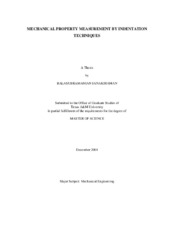| dc.description.abstract | The mechanical properties of materials are usually evaluated by performing a tensile or
hardness test on the sample. Tensile tests are often time consuming, destructive and need
specially prepared specimens. On the other hand, there is no direct theoretical correlation
between the hardness number and the mechanical properties of a material although
phenomenological relationships do exist. The advantages of indentation techniques are
that they are non-destructive, quick, and can be applied to small material samples and
localized in fashion. Mechanical properties are typically determined from spherical
indentation load-depth curves. This process is again a time consuming one and not
suitable for situations where a quick assessment is required such as in the sheet metal
rolling industry.
In the present study, a novel method of measuring mechanical properties of the material
by multiple spherical indentations is developed. A series of indentations are made on the
substrate with a spherical indenter with different loads. The diameter of the indentation is
related to the load applied to determine the mechanical properties of the material, namely
the yield strength and the work hardening parameters. To determine the diameter of the
indentation quickly, a fiber optic sensing technique is developed. An incident light beam
from a semiconductor laser is coupled back into an optical fiber upon reflection from the
metal surface. By measuring the diffused light power reflected from the metal surface,
the diameter of the indentation is measured.
The spherical indentation technique is difficult for real time mechanical property
measurement of sheet metal in a processing line. Problems arise as the strip is traveling at
2,000 to 4,000 ft/min (10,000 to 20,000 mm/sec) in the processing line. As a first step in
developing a process that could be implemented in a real time processing line, a
preliminary study has been conducted for the prediction of yield strength by laser shock
processing. | en |


